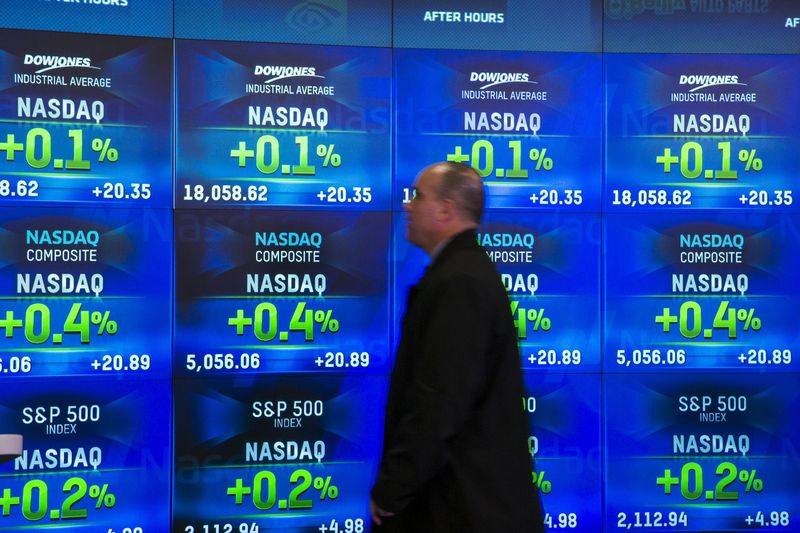Investing.com -- U.S. stocks edged higher Friday, ending a positive month on the up after key inflation data pointed to a cooling of inflationary pressures.
At 09:35 ET (13:35 GMT), Dow Jones Industrial Average rose 34 points, or 0.1%, S&P 500 traded 8 points, or 0.2% higher, and NASDAQ Composite climbed 10 points, or 0.42%.
The main indices are on course for robust gains in the first six months of 2024, which officially concludes with Friday’s closing. The S&P 500 is on track for gains on 15% year to date, the NASDAQ Composite is 19% higher, while the Dow Jones Industrial Average only gained 4%.
PCE data suggests cooling inflation
Inflation in the U.S. decelerated as expected in May compared to the prior month, according the Federal Reserve's preferred measure of price gains, potentially providing more impetus for the Fed to roll out interest rate cuts in 2024.
The headline personal consumption expenditures price index was flat on a monthly basis, retreating from a rise of 0.3% in April. In the 12 months to May, the figure also cooled to 2.6% from 2.7%.
Meanwhile, so-called "core" PCE, which strips out volatile items like food and fuel, eased to 0.1% month-on-month and 2.6% year-on-year.
This is a closely watched measure of inflation, widely regarded as the Federal Reserve's preferred gauge, and this moderation in price pressures is likely to strengthen the case for interest rate cuts this year.
The Fed is guiding for just one interest rate cut this year in December, but market participants still widely expect two cuts starting in September, hoping for a sustained downtrend in price pressures.
San Francisco Federal Reserve Bank President Mary Daly on Friday said she believes inflation is gradually cooling, saying the latest data showing inflation did not rise at all from April to May is "good news that policy is working."
"We are getting evidence that (policy) is tight enough," Daly told CNBC in an interview. "It's really challenging to look anywhere and not see monetary policy working. We have growth slowing, spending slowing, the labor market slowing, inflation coming down."
Still, Daly said, there is more work for policy to do, and she expects inflation to be above the Fed's 2% goal potentially through the end of 2025.
Presidential debate outcome
Investors are also digesting the first Presidential debate of the 2024 elections, between Democrat and Republican candidates Joe Biden and Donald Trump.
Biden appeared to struggle through much of Thursday's highly-anticipated 90-minute debate with Republican challenger Donald Trump, stumbling through questions put to him by the event's moderators.
Biden's performance was marked by a hoarse voice and a series of long pauses, which largely overshadowed his attacks on Trump's recent criminal conviction and his failure to accept democratic norms. Trump, meanwhile, took aim at Biden's record on the economy and foreign policy.
Nike slumps after flagging sales decline
Shares in Nike (NYSE:NKE) shed more than 17% after the sports apparel company told investors that revenue is expected to fall by 10% in the current quarter.
Sales in the ongoing fiscal year are also seen decreasing by a percentage in the mid-single digits.
Trump Media & Technology Group (NASDAQ:DJT) rose 6% after CNN’s flash poll showed that the Republican candidate has outperformed US President Joe Biden in the first presidential debate.
Infinera (NASDAQ:INFN) stock soared almost 20% after Nokia (HE:NOKIA) announced plans to buy U.S. optical networking gear maker in a $2.3 billion deal, amid plans to gain from the billions of dollars in investment pouring into data centres to cater to the rise of artificial intelligence.
Crude on track for weekly gain
Crude prices rose Friday, on course for the third consecutive winning week as fears of supply disruptions in Russia and the Middle East largely offset concerns over slowing demand.
By 09:35 ET, the U.S. crude futures (WTI) traded 0.2% higher at $81.94 per barrel, while the Brent contract climbed 0.2% to $85.43 per barrel.
Brent and WTI futures have gained nearly 2% so far this week, with both benchmarks also on track for gains of around 6% in June.
Fears of a wider war between Israel and Lebanon’s Hezbollah kept markets on edge over disruptions in crude supplies, while attacks by Ukraine on major Russian fuel refineries also pointed to potential disruptions in oil supplies from Moscow.
The geopolitical conflicts saw traders attach a higher risk premium to oil prices.
(Ambar Warrick contributed to this article.)
